![]()
![]()
![]()
Use LEFT and RIGHT arrow keys to navigate between flashcards;
Use UP and DOWN arrow keys to flip the card;
H to show hint;
A reads text to speech;
44 Cards in this Set
- Front
- Back
- 3rd side (hint)

|
Purse cover, Sutton Hoo, 7th c. CE |
-very abstract, but recognizable -ferocity of animal vs man -"animal style" -the beauty of it is more important than the image -importance of metalworkers -cloisonné: frames with enamel -symmetrical and organized, balance |
|

|
Palace Chapel of Charlemagne (or Palatine Chapel), Aachen, Odo of Metz, 8th c. CE |
-for Charlemagne's use only, throne -travelled to Italy, took influence from classical -copied the church in San Vitale, imported columns form Italy |
|
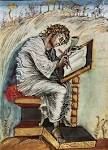
|
St. Matthew, Gospel Book of Archbishop Ebbo of Reims (or Ebbo Gospels), 9th c. CE |
-emotion is important, lines, movement, energetic, 'shaking with Divine Revelation' -angel of St. Mark in the corner, identification |
|
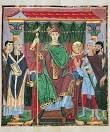
|
Otto III between Church and State, Gospel Book of Otto III, 10th c. CE |
-Byzantine influence; flanked by attendants like Justinian -hieratic scale -patterned, exaggerated heads and hands, petrified |
|
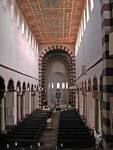
|
Abbey Church, Hildesheim, 11th c. CE |
-modules, rational, crossing proportions, organized, additive thinking -two apses, two services for the monastery and the town, didn't disturb each other |
|

|
Accusation and Judgement of Adam and Eve, Doors of Bishop Bernward, 11th c. CE |
-gestures create the narrative -basic elements only,barely any background -high relief, legibility -justified monumental art for illiterate people |
|
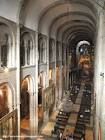
|
Cathedral, Santiago de Compostela, 11th c. CE |
-side aisle and apsidioles for pilgrimages modules, half the nave, additive thinking -stone vault, no windows, acoustics -compound piers ^drew from Classical |
|

|
Crowds Gaze at a Comet as Harold is told of the Omen, Bayeux Tapestry, 11th c. CE |
-incredibly detailed, but no shadows -stack heads to show a crowd, no depth -bent to conform to boundaries |
|
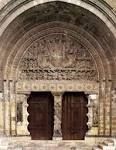
|
South Portal, Abbey Church, Moissac, 12th c. CE |
-fortified, exclusive -hieratic scale, Christ -2nd coming, surrounded by saints and angels -emotional, stylized figures, twist |
|

|
Saint-Étienne, Caen, 12th c. CE |
-penance for marrying his cousin -westwork, fortified -ribbed groin vault, windows |
|
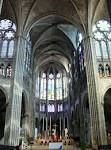
|
Choir, Church of St. Denis, 1140s CE |
-relics in the crypt under the choir -additive thinking is gone, integrated/unified approach -pointed vaults take the weight downwards -light goes through stained glass without breaking it, penetration |
|

|
West Façade (or Royal Portal), Cathedral, Chartres, 1140s CE |
-north portal: ascension, center portal: 2nd coming, south portal: birth -figures and animals becoming more natural -there's the idea of texture beginning -humanity of Christ, calmer |
|
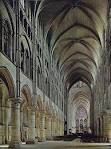
|
Nave, Cathedral, Laon, 1180s CE |
-four part elevation, triforium added under the clerestory -wind creates cracks, flying buttresses |
|

|
Nave, Cathedral, Chartres, 1200s CE |
-relic: garment Mary wore during Christ's birth -transept in the middle of the church -two side aisles, pilgrims -elasticity, eye travels up and down the nave
|
|
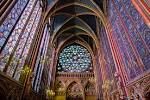
|
Sainte-Chapelle, Paris, 1240s CE |
-king and his family's private use -reliquary as a building, canopy, crown of thorns, sponge, nail, part of the cross -stained glass and gold, blue ceiling -rayonant style |
|

|
Annunciation and Visitation, Cathedral, Reims, 1250s CE |
-3 different artists: >visitation done in Classical style, drapery, painted, s curve >Mary in the enunciation, sober style, severe >enunciate angel, courtly style, emphasized long proportions, smaller head, Parisian style |
|

|
Choir Screen, Cathedral, Naumburg, 1250s CE |
-blocks the view of the eucharist -passion of Christ -body on the trumeau, arms on the lintel -emotion, mourning, God understands pain |
|

|
Pulpit, Pisa, Nicola Pisano, 1250s CE |
-Classical influence -elevate the priest -images for the illiterate -trefoil arch -multicoloured marble -figures represent virtues, fortitude (could be Hercules or Daniel), gothic sway, realistic -volume showing anatomy |
|
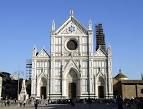
|
Sta. Croce, Florence, Arnolfo di Cambio, 1290s CE |
-built in the middle of the city, mendicant monks go to the people -simplified, like early Christian art -verticality of gothic, with horizontal moulding that breaks your eye -trussed room, not vaulted -wide, accommodate many people |
|

|
Arena Chapel (or Scrovegni Chapel), Padua, Giotto, 1300s CE |
-his father got his money from usury, penance church, appeals to the Virgin for charity -frescoes, early Christian, registers -enunciation all the way to judgement as you exit -dramatic emotion -compositionally clear |
|

|
Maestà Altarpiece, Duccio, 1300s CE |
-polyptych -narratives -largest scene of Mary enthroned, Byzantine features, some modelling with light and shadow, gold/siennese line, maternal |
|
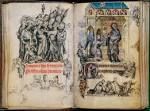
|
Betrayal of Christ and Annunciation, Hours of Jeanne d'Évreux, Pucelle, 1320s CE |
-queen depicted praying -grisaille with some colour -gothic sway, tiny heads and hands -surrounded by secular scenes, metaphor between the scenes -figures occupying a space, no scale though |
|
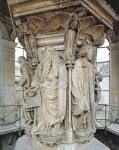
|
The Well of Moses, Chartreuse de Champmol, Sluter, 1400s CE |
-crucifixion on top, blood of Christ -prophets on each side, bursting free, individuality, horns on Moses (mistranslated rays of light), long legs hidden under thick drapery |
|

|
St. Mark (or San Michele), Florence, Donatello, 1410s CE |
-for the linen makers guild, cushion -Classical style, proportions, contrapposto, volume -potential to move and speak |
|

|
Hospital of the Innocents, Florence, Brunelleschi, 1420s CE |
-opened onto a piazza, loggia -hospital for children and orphans -logical, modules, based on antiquity |
|

|
The Holy Trinity, Sta. Maria Novella, Florence, Masaccio, 1420s CE |
-donors on each side -fresco -Holy Trinity, God floats in space -Classical architecture -vanishing point at eye level -triangles -figures in the front -modelling with light and shadow |
|
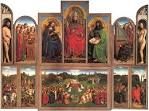
|
The Ghent Altarpiece, Hubert and Jan van Eyck, 1430s CE |
-polyptych with doors -two registers: >bottom, landscape, crowd extending in space, lamb of Christ on the altar, detailed >top, heavenly court -Adam and Eve, long legs, pear shape, Parisian style -Cain and Abel, sin passed on |
|
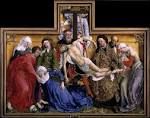
|
Descent from the Cross, Rogier van der Weyden, 1430s CE |
-for the crossbowman's guild, corners -emotional response, emotion, tears, red faces, contemplative -figures pushed to the front -eye is pulled in circles -Mary's palour imitates Christ, she suffers as well |
|
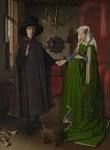
|
The "Arnolfini Portrait", Jan van Eyck, 1430s CE |
-marriage contract, signed on the wall -pear shape, not pregnant -transfer of goods -no emotion |
|

|
David, Donatello, ca. 1440s CE |
-Youthful,Classical ideal -sword of Goliath, too big -narrative contrapposto, looking down at the head, foot on head -first freestanding male nude since antiquity -sympathetic movement -realization of his capability -Medici's saw themselves as David, protecting the state |
|
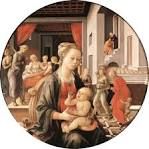
|
The Bartolini Tondo, Fra. Filippo Lippi, 1450s CE |
-Mary's parents told they were going to have a child, birth of Mary, Mary with baby -celebration of motherhood and fertility, pomegranate -familial setting -disjointed perspective, sense of different times |
|
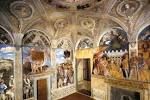
|
Camera Picta (or Painted Room), Ducal Palace, Mantua, Mantegna, 1460s CE |
-tromp l'oeuil, looks like real windows -no specific function -no atmospheric perspective -corvals project from the walls and support the arches -individualized portraits -foreshortening of babies -flaunting wealth, little people -sense of play and humour |
|

|
The Portinari Altarpiece, Hugo van der Goes, 1470s CE |
-contemplative mixed with symbolism, wheat for bread, red lilies for blood -nativity is the beginning of salvation -hieratic scale -shepherds usually pictured clean, instead, they are rugged, real |
|
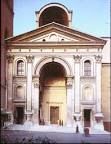
|
Church of Sant'Andrea, Mantua, Alberti, 1470s CE |
-blend of Classical and Early Christian styles -triumphal arch with entablature and pediment -colossal pilasters, more than one storey tall -perfect square -can't see the nave from the ground, but it actually surpasses the façade -repeated inside |
|

|
The Birth of Venus, Botticelli, 1480s CE |
-goddess of love, most beautiful -contemplation of beauty, reach the divine through beauty -gold lines in her hair -stable composition, triangle |
|
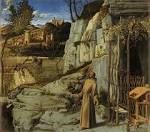
|
St. Francis in the Desert, Giovanni Bellini, 1480s CE |
-sense of light, Venetian -patron of animals, communed with nature -linear perspective -golden light, communing with God? about to receive the stimatta? when he conceived the hymn of the Sun? |
|

|
Last Supper, Sta. Maria delle Grazie, Milan, Leonardo da Vinci, 1490s CE |
-mixed oil and tempera like an idiot -linear perspective, vanishing point behind Christ's head -door serves as a halo -Judas with his hand on the table, holding the money -balanced, but not symmetrical |
|

|
Pietà, Michelangelo, 1490s CE |
-hired by a french cardinal and inspired by northern art -sorrowful, looking down -beauty, wounds aren't gory -hips too wide when viewed head on |
|
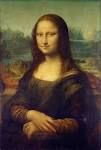
|
Mona Lisa, Leonardo da Vinci, 1500s CE |
-wife of a prominent Florentine, wearing simple garments -shows personality, not status -fantastical background -¾ view, innovative -sfumatto, soft -tilting forward, engaging the viewer |
|
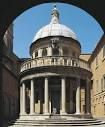
|
Tempietto, Bramante, 1500s CE |
-marking the spot where St. Peter was crucified, upside down, martyrium -centrally planned, not for large processions, 7 people max -classical influence, tuscan columns, entablature, triglyphs and metopes with Christian scenes -originally supposed to be part of a space, courtyard, colonnade and buildings, in the shape of a cross, airy -sculpted exterior, undulating |
|

|
Ceiling, Sistine Chapel, Vatican Palace, Michelangelo, 1500s CE |
-fired all of his assistants -varied sizes creates pulsating movement -Genesis until Noah's arc, prophets -fewer figures on the later half, bigger, muscular -The Creation of Adam, transfer of energy when they touch -Libian Cibyl, twisting, but not precarious, drawn form a man |
|
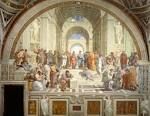
|
The School of Athens (or Philosophy), Room of the Signature, Vatican, Raphael, 1500s CE |
-linear perspective, vanishing point behind Plato and Aristotle -differing views, Plato pointing up, Aristotle pointing down, two halves -groups of figures moving and interacting -massive bodies, inspired by Michelangelo -weaping philosopher is Michelangelo, went back and put him in, contemporary clothing |
|
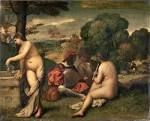
|
Pastoral Symphony, Giorgione, 1500s CE |
-Venetian light -moods, atmospheres, emotions, poetic -no source for what he's painting -women are distant from the scene, Muses? -ideal land -hazy, Leonardo's influence |
|
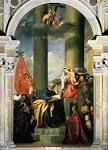
|
Madonna with Members of the Pesaro Family, Titian, 1520s CE |
-patron kneeling at the base of the stairs -military saint behind him -Peter on the stairs, Pope, mediator -Mary and Christ at the top -other males on the other side with St. Francis above them -triangle with a more dynamic rise -position of the piece, came towards it at an angle, be able to see Mary -unknown setting -figures direct you, pulled in by the figure looking at you |

